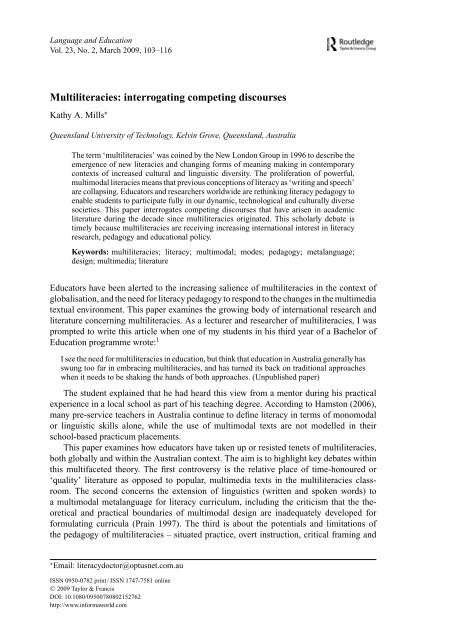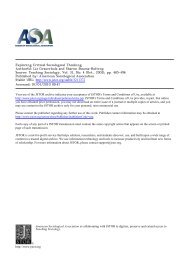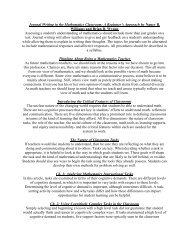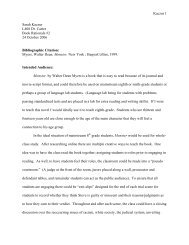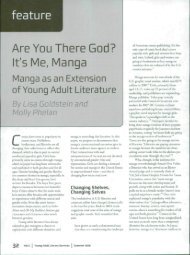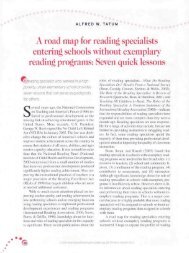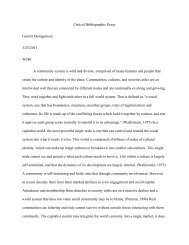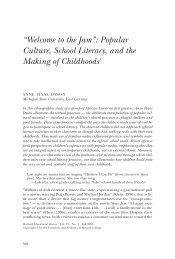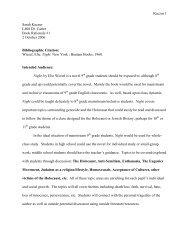Mills (2009) Interogating competing multiliteracy ... - Oncourse
Mills (2009) Interogating competing multiliteracy ... - Oncourse
Mills (2009) Interogating competing multiliteracy ... - Oncourse
You also want an ePaper? Increase the reach of your titles
YUMPU automatically turns print PDFs into web optimized ePapers that Google loves.
Language and Education<br />
Vol. 23, No. 2, March <strong>2009</strong>, 103–116<br />
Multiliteracies: interrogating <strong>competing</strong> discourses<br />
Kathy A. <strong>Mills</strong> ∗<br />
Queensland University of Technology, Kelvin Grove, Queensland, Australia<br />
The term ‘multiliteracies’ was coined by the New London Group in 1996 to describe the<br />
emergence of new literacies and changing forms of meaning making in contemporary<br />
contexts of increased cultural and linguistic diversity. The proliferation of powerful,<br />
multimodal literacies means that previous conceptions of literacy as ‘writing and speech’<br />
are collapsing. Educators and researchers worldwide are rethinking literacy pedagogy to<br />
enable students to participate fully in our dynamic, technological and culturally diverse<br />
societies. This paper interrogates <strong>competing</strong> discourses that have arisen in academic<br />
literature during the decade since multiliteracies originated. This scholarly debate is<br />
timely because multiliteracies are receiving increasing international interest in literacy<br />
research, pedagogy and educational policy.<br />
Keywords: multiliteracies; literacy; multimodal; modes; pedagogy; metalanguage;<br />
design; multimedia; literature<br />
Educators have been alerted to the increasing salience of multiliteracies in the context of<br />
globalisation, and the need for literacy pedagogy to respond to the changes in the multimedia<br />
textual environment. This paper examines the growing body of international research and<br />
literature concerning multiliteracies. As a lecturer and researcher of multiliteracies, I was<br />
prompted to write this article when one of my students in his third year of a Bachelor of<br />
Education programme wrote: 1<br />
I see the need for multiliteracies in education, but think that education in Australia generally has<br />
swung too far in embracing multiliteracies, and has turned its back on traditional approaches<br />
when it needs to be shaking the hands of both approaches. (Unpublished paper)<br />
The student explained that he had heard this view from a mentor during his practical<br />
experience in a local school as part of his teaching degree. According to Hamston (2006),<br />
many pre-service teachers in Australia continue to define literacy in terms of monomodal<br />
or linguistic skills alone, while the use of multimodal texts are not modelled in their<br />
school-based practicum placements.<br />
This paper examines how educators have taken up or resisted tenets of multiliteracies,<br />
both globally and within the Australian context. The aim is to highlight key debates within<br />
this multifaceted theory. The first controversy is the relative place of time-honoured or<br />
‘quality’ literature as opposed to popular, multimedia texts in the multiliteracies classroom.<br />
The second concerns the extension of linguistics (written and spoken words) to<br />
a multimodal metalanguage for literacy curriculum, including the criticism that the theoretical<br />
and practical boundaries of multimodal design are inadequately developed for<br />
formulating curricula (Prain 1997). The third is about the potentials and limitations of<br />
the pedagogy of multiliteracies – situated practice, overt instruction, critical framing and<br />
∗ Email: literacydoctor@optusnet.com.au<br />
ISSN 0950-0782 print / ISSN 1747-7581 online<br />
C○ <strong>2009</strong> Taylor & Francis<br />
DOI: 10.1080/09500780802152762<br />
http://www.informaworld.com
104 K.A. <strong>Mills</strong><br />
transformed practice, which is evaluated in the light of recent classroom-based research<br />
(New London Group 2000). I draw from my classroom-based ethnographic research, in<br />
which I examined first-hand the application of the multiliteracies pedagogy with students<br />
from diverse ethnic backgrounds (<strong>Mills</strong> 2005a, 2005b, 2006a, 2006b, 2006c, 2006d, 2007a,<br />
2007b).<br />
Describing multiliteracies<br />
More than a decade ago, a group of 10 educators met together in New London. They<br />
advocated a new approach to literacy pedagogy in response to the changes in the globalised<br />
communication environment (New London Group 1996). They proposed a pedagogy of<br />
multiliteracies to broaden approaches to literacy that were centred exclusively on linguistics,<br />
to include multimodal textual practices – combining linguistic, visual, audio, gestural<br />
and spatial modes – and literacies that were culturally inclusive (Cope and Kalantzis<br />
2000a).<br />
Specifically, the term ‘multiliteracies’ was coined by the New London Group (1996) to<br />
encompass two powerful propositions in the changing communications environment. The<br />
first concerns the multiplicity of communication channels and media tied to the expansion<br />
of mass media, multimedia and the Internet, while the second pertains to the increasing<br />
importance of cultural and linguistic diversity as a consequence of migration and globally<br />
marketed services (New London Group 1996). These two propositions are related<br />
because the proliferation of texts is partially attributed to the diversity of cultures and<br />
subcultures (Cope and Kalantzis 2000b). For example, in Aboriginal cultures the visual<br />
mode of representation is much richer and more evocative than linguistics alone (Cope<br />
and Kalantzis 2000b). Likewise, gestural modes of communication, represented through<br />
dance and holistic expressions of movement, are an integral part of Sudanese culture (<strong>Mills</strong><br />
2006c).<br />
In the decade since the work of the New London Group began, the multiliteracies<br />
argument has been used to emphasise the importance of oral vernacular genres (Newman<br />
2005), visual literacies (Burton 2006; Callow 2006; Noad 2005; O’Brien 2001), information<br />
literacy (Hodgman 2005), emotional literacy (Liau et al. 2003) and the visual and<br />
performing arts (Hertzberg 2001; Makin and Whiteman 2007; Martello 2004; Thwaites<br />
1999). Recently, it has been applied to understandings of geographical, historical, political,<br />
economic, ecological (environmental) and cultural literacies in the context of the social<br />
education (Muller 2006; Schultz 2006). The concept of multiliteracies has been extended<br />
beyond language and cultural studies to address scientific multiliteracies (Weinstein 2006)<br />
and numeracy (Every and Young 2002).<br />
The application of the concept of ‘multiliteracies’ to a broad range of academic disciplines<br />
prompts concerns about the marginalisation of conventional approaches to literacy<br />
curriculum. As interpretations of multiliteracies become, more inclusive in the literature,<br />
it is timely to recall that the multiliteracies argument was originally framed in the context<br />
of the New London Groups’ discussions about ‘literacy and literacy teaching and learning’<br />
(New London Group 2000, 9). Cope and Kalantzis, members of the group, state explicitly:<br />
We began the discussion with an agenda that we had agreed upon in advance, which consisted<br />
of a schematic framework of key questions about the forms and content of literacy pedagogy.<br />
(Cope and Kalantzis 2000a, 7)<br />
Despite the application of multiliteracies to a broad range of academic disciplines, this<br />
dialogue is positioned in the context of literacy pedagogy.
Language and Education 105<br />
Multiliteracies, literature and popular texts<br />
A growing body of multiliteracies research is centred on the relevance of a burgeoning array<br />
of popular, oral vernacular and mass media texts (Mackey 2003; Mason 2004; Newman<br />
2005; Nixon and Comber 2001; Stevens 2001). A key emphasis of multiliteracies is the<br />
need for literacy curricula to incorporate a widening range of digital text types with their<br />
associated boundaries of generic structure that are less visible than those of time-honoured,<br />
written forms. For example, Newman (2005) cites the multiliteracies argument to frame a<br />
textual analysis of hip-hop ciphers, applying Halliday’s functional linguistics. Walsh (2006)<br />
reported on the incorporation of visual literacies in a language programme, highlighting the<br />
hypermedia design skills evident in the portfolio websites of adolescent students. Callow<br />
(2006) examined the visual metalanguage used in the classroom when analysing the images<br />
in political advertising. These examples point to the current emphasis on popular and<br />
pervasive multimedia texts in multiliteracies research and classroom practice.<br />
This emphasis on the dynamic representational resources used in popular, multimodal<br />
texts may raise concerns among educators who value the unchanging merit and meaning of<br />
‘historically ratified texts’ – a cultural heritage approach (Hollingdale 1995, 249). At the<br />
symposium ‘English Beyond the Battle Lines: Rethinking English Today’ by the English<br />
Teachers Association of Queensland (ETAQ), Professor Buckridge stated that Queensland<br />
faced the ‘imminent disappearance of the literary canon’ if literature was not restored in<br />
schools (Livingstone 2007, 3):<br />
In ecological terms, the thing we’re on the brink of losing can be thought of as a huge and<br />
priceless piece of cultural heritage to which everyone in Australia and the rest of the world has<br />
an inalienable right of access . . .<br />
Are teachers of multiliteracies replacing time-honoured, ‘quality’, classical English<br />
literature with transient, informal, abbreviated forms of electronic communication and<br />
inferior, consumer-driven mass-media texts<br />
There are three logical reasons why a multiliteracies pedagogy sits uneasily with a<br />
cultural-heritage approach. Firstly, multiliteracies aims to move literacy education forward<br />
from antiquated pedagogies of an exclusively formal, standard, monomodal and national<br />
language to those that are inclusive of informal, open-ended, multimodal forms of communication,<br />
which cross national boundaries and support productive diversity (Cope and<br />
Kalantzis 2000b). From this standpoint, the intertextual institution of a dominant literary<br />
tradition is inequitable, since marginalised cultures also have a stake in literacy practice in<br />
a multicultural and globalised society (<strong>Mills</strong> 2005a).<br />
This brings us to a second argument: advocates of multiliteracies see reading as a critical,<br />
social practice, rather than purely a means of cultural transmission. Critical framing within<br />
a pedagogy of multiliteracies involves the development of alternative reading positions and<br />
practices for questioning and critiquing texts, with their affiliated social formations and<br />
culturally specific assumptions (Cope and Kalantzis 2000b). This aspect of a pedagogy<br />
of multiliteracies builds upon ‘critical literacy’, in which texts are viewed as sites where<br />
culture is produced or reproduced (Kamler 1994; Knobel and Healy 1998; Macken-Horarik<br />
1996). The selection of ‘quality’ literature is a culturally and politically complex act; it is<br />
ideologically value-laden (Anstey and Bull 2004; Baker and Luke 1991; Durrant and Green<br />
2000; Macken-Horarik 1997; West 1992). Multiliteracies challenges the appropriateness<br />
of these decisions, taking into account the interests of all students in increasingly diverse<br />
communities. Rather than using texts in the reproduction of the dominant cultural values of<br />
the West, critical framing in multiliteracies pedagogy stimulates students’ thinking about<br />
how textual practices work in the construction of subjectivity and production of culture.
106 K.A. <strong>Mills</strong><br />
Furthermore, this debate can be framed in the light of the diverse purposes of literacy<br />
in society today. Historically valued texts are not representative of the kaleidoscope<br />
of texts and literacies that children encounter in society. For example, the valued literature<br />
canon systematically excludes certain text types such as picture books, popular texts,<br />
romance and science fiction (<strong>Mills</strong> 2005a). Removing these popular fictions from the curriculum<br />
disenfranchises many groups and negates valuable opportunities to meet children’s<br />
interests. At the same time, ignoring the pervasiveness of popular culture leaves a significant<br />
number of gendered representations and stereotypes unopposed and unquestioned<br />
(Arthur 2001; Hollingdale 1995; Muspratt, Luke, and Freebody 1997; Singh 1997; West<br />
1992; Wyatt-Smith 2000). A pedagogy of multiliteracies provides opportunity for this critique.<br />
Furthermore, information texts, emails, websites, databases, visual literacies and oral<br />
discourses should not be overlooked as ‘inferior literacies’. In relation to the hierarchical<br />
ordering of textual practice, Luke (2000, 85) argues:<br />
...the‘new’electronicwriting is a different form of literacy – not an inferior or lesser form<br />
of some ‘golden age’ vision of literacy. The electronic typewriter was not a diminished form<br />
of literacy or handwriting . . .<br />
It is not argued here that there is no space for time-honoured, ‘quality’ literature in a<br />
pedagogy of multiliteracies. For example, some scholars have published work concerning<br />
both literature and multiliteracies, such as Unsworth (2006a, 2006b) and Mackey (1998),<br />
among others. These theorists have shown that the distinctions between ‘quality literature’<br />
and ‘popular culture’ is increasingly becoming blurred by a burgeoning variety of children’s<br />
literature and classic stories in electronic formats, published as CD-ROM versions and on the<br />
World Wide Web, supported by online communities, forums and chat rooms about literature<br />
(Unsworth et al. 2005). Whether ‘classical’ or ‘popular’, multimodal or monomodal, digital<br />
or not, the selection of texts for teaching multiliteracies needs to be done reflectively and<br />
critically. Failure to do so results in the reproduction of dominant cultural values, and<br />
compliance with the ‘literary tastes of the most powerful’ (Muspratt et al. 1997, 297).<br />
Multimodal design<br />
This section addresses the contention that the New London Group’s extension of linguistics<br />
(written and spoken words) to include multimodal texts is too broad to be useful to literacy<br />
curriculum and practice. Multimodality expresses the complexity and interrelationship<br />
of more than one mode of meaning, combining linguistic, visual, auditory, gestural or<br />
spatial modes. Visual meanings or modes include images, page layouts, screen formats,<br />
colours, perspectives, vectors, foregrounding and backgrounding. Audio meanings include<br />
music, voice-overs and sound effects. Gestural design involves body language, gestures,<br />
kinesics, feelings and behaviour. Spatial design includes environmental, architectural and<br />
geographical meanings (Kress 2000a; New London Group 2000).<br />
Multimodal design differs from independent modes because it interconnects the modes<br />
in dynamic relationships. It captures the multifaceted and holistic nature of human expression<br />
and perception, involving the whole body in the process of learning and semiosis<br />
(Kress 2000a, 2000b; New London Group 2000). It was members of the New London<br />
Group (2000, 19) who began to extend the linguistic semiotic system of Halliday (1978,<br />
1994) to incorporate visual, spatial, gestural and audio modes in a metalanguage of design<br />
(Cope 2000; Cope and Kalantzis 1999; Kress 2000a, 2000b; Kress and van Leeuwen 1996,<br />
2001). The New London Group (2000, 25–28) also uses the terms ‘meanings’, ‘modes of<br />
meaning’, ‘designs’ and ‘design elements’ as synonyms for ‘modes’.
Language and Education 107<br />
The semiotic aspects or metalanguage for multiliteracies has not been without criticism<br />
at various points in its development (Cameron 2000; Pennycook 1996; Prain 1997; Trimbur<br />
2001). For example, Prain (1997) criticises the New London Group for claiming that<br />
static rules do not govern meaning making, while in practice providing elaborate codes<br />
and checklists of stable multimodal and linguistic elements based on Halliday’s functional<br />
grammar (1994). This, Prain suggests, contradicts their appeal to the multifarious, hybrid<br />
texts that are proliferating and ever changing. He also argues that the reformulation of<br />
linguistic grammars to include the five modes of design has opened up an unwieldy number<br />
of text types to be addressed in literacy education, requiring semiotic tools of analysis<br />
that the New London Group has not provided. Prain (1997) contends that the theoretical<br />
and practical boundaries of multimodal design are inadequately developed for formulating<br />
curricula and are currently unsuitable for classroom discussion.<br />
The New London Group (1996) does not propose that multiliteracies is a completed<br />
project. Cope and Kalantzis (1997, 2000b) called for the ongoing reformulation of a multimodal<br />
metalanguage, and scholars and researchers have responded by continuing this<br />
dialogue. In particular, the ongoing extension of Halliday’s work to multimodal semiosis<br />
has been taken up by several theorists since the New London Group. For example, Unsworth<br />
(2001, 2006a) and Jewitt (2006) follow Kress (1996) in applying categories of systemic<br />
functional linguistics – representational or ideational, interactive or interpersonal and compositional<br />
or textual meanings – to the metafunctional organisation of multimodal texts.<br />
Since the New London Group, theorists have continued to develop a new metalanguage<br />
or grammar for describing the confluence of different words, images, sounds, gestures and<br />
spatial elements of multimodal textual designs (Burn and Parker 2003; Burton 2006; Callow<br />
2006; Clancy and Lowrie 2002; Hamston 2006; Hull and Nelson 2005; Jewitt 2006; Jewitt<br />
and Kress 2003a, 2003b; Kress 2000b; Kress et al. 2001; Kress and van Leeuwen 2001;<br />
Noad 2005; O’Brien 2001; Osbourne and Wilson 2003; Stein 2007; Stein and Slonimsky<br />
2006; Unsworth 2001, 2006b; Watson and Johnson 2004).<br />
Jewitt and Kress (2003b, 290), who have contributed much to the development of<br />
multimodal semiotics, acknowledge that because ‘multimodality attends to everything as<br />
meaningful’ it is sometimes perceived as ‘imperialistic’. Jewitt and Kress (2003a, 290)<br />
counter that multimodality is a new venture, and thus, multimodal semioticians need to<br />
examine precisely ‘where the boundaries of its affective work are located’.<br />
In response to the criticism that multimodality semiotics is too broad for literacy<br />
curriculum, it needs to be acknowledged that the multimodal quality of texts is a reality<br />
of our fast-changing, globalised textual environment. Teaching literacy exclusively as a<br />
stable, autonomous system of linguistic conventions and rules is no longer sufficient for the<br />
multiple platforms of communication in society (Kress 2000a). Likewise, the multimodal<br />
nature of semiotics should no longer be ignored in contemporary theories of meaning.<br />
Systems of meaning are fluid – created, developed and transformed in response to the<br />
communicative needs of society (Kress et al. 2001). Consider, for example, that the written<br />
discourses of online chat rooms are more abbreviated, interactive, spontaneous, informal,<br />
spoken-like and rapidly transmitted than many print-based texts. These networked textual<br />
practices generate new ‘standard’ terms that are widely recognised by competent users of the<br />
discourses, such as ‘lol’ (laughing out loud) or ‘afk’ (away from keyboard). Colloquial forms<br />
or minimal reinforcers such as ‘ah’ and ‘mmm’ convey a similar degree of spontaneity and<br />
responsiveness to speech, within an extensively ‘threaded’ organisational structure of the<br />
text (Love and Isles 2006, 220). This highlights the need for a multimodal metalanguage that<br />
accounts for the dynamic, temporal and varied affordances of new media and textual practices<br />
in relation to different social contexts and cultural purposes (New London Group 2000).
108 K.A. <strong>Mills</strong><br />
Conversely, there are aspects of Internet discussion threads that essentially remain<br />
regular and stable. For example, when users identify a spelling error in their transmitted text,<br />
a common practice is to immediately forward the corrected spelling, flagged by an asterisk.<br />
Large repertoires of English words used in online discussions have no commonly recognised<br />
abbreviations, and users must draw upon ‘standard’ spelling. New textual designs always<br />
build on existing resources for meaning making, having a degree of familiarity that enables<br />
the formulation of descriptive and analytic categories to describe texts (Cope and Kalantzis<br />
1997).<br />
The multiliteracies argument has awakened literacy educators to recognise that the skills<br />
required to communicate effectively in society are constantly changing. In particular, cultural<br />
differences and a proliferation of communications media give impetus for a pedagogy<br />
of multiliteracies for locally diverse, educational contexts (LoBianco 2000; New London<br />
Group 2000). Interestingly, syllabi across the seven states and territories in Australia, where<br />
this paper is written, address the need for students to design multimodal texts for a variety<br />
of social purposes (ACT Department of Education and Training 2000; Board of Studies<br />
New South Wales 1998; Department of Education and Training Tasmania 2007; Department<br />
of Education and Training Western Australia 2005; Department of Employment Education<br />
and Training Northern Territory 2005; South Australian Department of Education and<br />
Children’s Services 2004; Queensland Studies Authority 2006; Victorian Curriculum and<br />
Assessment Authority 2005).<br />
The semiotic terrain is undeniably changing in fundamental ways, and this transformation<br />
requires the continued revision of metalanguages or new grammars to describe the<br />
burgeoning and hybridised variety of text forms associated with information and multimedia<br />
technologies (New London Group 1996). To continue to teach to a narrow band of<br />
print-based genres, grammars and skills is to ignore the reality of textual practices outside<br />
of schools. Students must be free to engage in new and multimodal textual practices, rather<br />
than simply reproduce a tightly confined set of linguistic conventions.<br />
Multiliteracies pedagogy<br />
Despite the prominence of multiliteracies in international literacy research since the New<br />
London Group’s paper in the Harvard Educational Review (1996), the multiliteracies pedagogy<br />
– the ‘how’ of multiliteracies – has been received with both enthusiasm and reservations.<br />
The New London Group had envisaged that a multiliteracies pedagogy might provide<br />
‘access without children having to erase or leave behind different subjectivities’ and to be<br />
‘genuinely fair in the distribution of opportunity’ (New London Group 2000, 18). The multiliteracies<br />
pedagogy of the New London Group involves four related components: situated<br />
practice, overt instruction, critical framing and transformed practice (New London Group<br />
2000). Situated practice involves building on the lifeworld experiences of students, situating<br />
meaning making in real-world contexts. Overt instruction guides students to use an explicit<br />
metalanguage of design. Critical framing encourages students to interpret the social context<br />
and purpose of designs of meaning. Transformed practice occurs when students transform<br />
existing meanings to design new meanings (New London Group 1996). These components<br />
of the pedagogy do not constitute a linear hierarchy, but may occur simultaneously, randomly<br />
or be ‘related in complex ways . . . each of them repeatedly revisited at different<br />
levels’ (New London Group 2000, 32).<br />
An example of an initially ambivalent response to the multiliteracies pedagogy appears<br />
in a monograph edited by key members of the New London Group, Cope and Kalantzis<br />
(2001). Auerbach (2001) argues that the notion of accommodating four pedagogical
Language and Education 109<br />
traditions has the potential to be both problematic and productive, grounded in a concern<br />
that the multiliteracies pedagogy may neglect irreconcilable ideological tensions between<br />
each approach. Auerbach (2001, 99) cautions that ‘unless the ideological basis of each of<br />
the four components and their implications for practice are made explicit, the pedagogy lays<br />
itself open to distortion or cooption’. The argument is not that overt instruction, situated<br />
practice, critical framing and transformed practice are necessarily or inherently oppositional;<br />
rather, there is a call for explication of their ideological stance and implications for<br />
the multiliteracies pedagogy. Interestingly, this is coupled with a caveat that the framework<br />
should not be able to disregard central issues of power and ideology that have existed in<br />
schooling, ignoring ways that the social construction of literacy has historically served as<br />
a tool for reproducing the existing social order (Auerbach 2001).<br />
Investigating this issue of power, my ethnographic classroom research examined the<br />
enactment of the multiliteracies pedagogy through the theoretical lens of critical theory<br />
(<strong>Mills</strong> 2005a, 2005b, 2006a, 2006b, 2006c, 2006d, 2007a, 2007b). The study documented a<br />
teacher’s enactment of the multiliteracies pedagogy through a series of multimodal, mediabased<br />
lessons with her culturally and linguistically diverse students of class six (aged<br />
11–12 years). A salient finding was that students’ access to multimodal semiosis was not<br />
distributed equally because of complex interactions between the enactment of the multiliteracies<br />
pedagogy, power relations and classroom discourses. Existing degrees of access<br />
were reproduced, based on the learners’ relation to the dominant culture. Specifically, students<br />
from Anglo-Australian, middle-class backgrounds had greater access to transformed<br />
designing than those who were culturally or economically (<strong>Mills</strong> 2007b).<br />
For example, the influence of power on students’ access to multiliteracies was shown<br />
when a group of economically marginalised boys were prohibited from completing the<br />
multimodal, digital aspects of moviemaking because they were disruptive in class and<br />
received established sanctions. Instead, they were required to do monomodal literacies<br />
consisting of handwritten work. Consequently, the enactment of coercive power prohibited<br />
these boys from being socialised into valued multiliterate practices of contemporary society<br />
(<strong>Mills</strong> 2007b).<br />
In relation to pedagogy, the symbolic practice of ability grouping for English was found<br />
to be a constraining form of differentiation, distributing different literacies to students in a<br />
marginalising way. The low-ability group received monomodal literacies and transmissive<br />
forms of pedagogy, which created the conditions for further marginalisation. Transmissive<br />
pedagogy used to regulate the behaviour of the low-ability literacy group did not foster<br />
decision-making, communication or creative and technological skills that are required to<br />
transcend working-class jobs. Furthermore, the low-ability groups comprised the culturally,<br />
linguistically and socio-economically marginalised students. Therefore, the ability grouping<br />
for English unintentionally contributed to a non-reflexive causal loop that sustained the<br />
unequal distribution of multiliteracies (<strong>Mills</strong> 2005b, 2007a).<br />
Classroom discourses – required ways of speaking and act in the classroom – also<br />
influenced students’ access to multiliteracies. For example, Ted, an Indigenous Australian<br />
student, continually violated the discursive patterns or rules by which discourses were<br />
formed and that governed what could be said or remain unsaid, and who could speak with<br />
authority or remain silent (McLaren 1994). Ted was frequently reprimanded for ‘unsolicited<br />
replying’ – calling answers without being nominated by the teacher. A common pattern of<br />
classroom discourse in Western schooling requires interactions by invitation of the teacher in<br />
whole-class discussions. However, unsolicited replying is a common Indigenous Australian<br />
discourse pattern (Cazden 1988). In contrast, Anglo-Australian, middle-class students were<br />
consistently able to report on their work to satisfy the expectations of the teacher. They
110 K.A. <strong>Mills</strong><br />
were selected to become spokespersons for groups. They gained control of classroom<br />
discussions by raising their hands – ‘Warren, I see your hand up – you’re in control’. Such<br />
ways of acting and speaking in the multiliteracies classroom were considered successful by<br />
the teacher. Dominant students gained rewards, praise and power in directing whole-class<br />
discussions because they sat upright with their hands on their heads and assumed other<br />
required postures (<strong>Mills</strong> 2006b).<br />
In summary, the research demonstrated that irrespective of the relative merits of the<br />
multiliteracies pedagogy over conventional approaches, its ability to provide equitable<br />
access for all must be understood in relation to the complex network of power relations in<br />
the institution of schooling that both constrain and enable its successful implementation<br />
(<strong>Mills</strong> 2006c).<br />
These findings are supported by Janks (2004), who reported the observations in a South<br />
African school in which teachers code-switched between the local language – Setswana –<br />
and English. By grade seven, students were to respond only in English, prohibiting 90%<br />
of the students, who had not mastered the dominant language, from speaking. Following<br />
Bourdieu, who posited the ‘access paradox’ in 1991, Janks’ work draws attention to the<br />
consequences for students’ access to language when issues of dominance are ignored.<br />
So are literacy educators and researchers celebrating or censuring the multiliteracies<br />
pedagogy On the one hand, Sydney-based research in 2001 indicated that the multiliteracies<br />
pedagogy was implemented in a number of specific sites, but had less impact<br />
than Freebody and Luke’s (1990) ‘four reader roles’ (code-breaker, text participant, textuser<br />
and text analyst), as well as ‘explicit and systematic’ pedagogies (Hammond 2001;<br />
Hammond and Macken-Horarik 1999). However, throughout the last decade, the multiliteracies<br />
pedagogy and the framework of ‘knowledge processes’ – experiencing known<br />
and new, conceptualising by naming and theorising, analysing functionally and critically,<br />
and applying appropriately and creatively – have been applied across a range of levels of<br />
educational institutions globally (Kalantzis and Cope 2005).<br />
There are early reports of the successful implementation of the multiliteracies pedagogy<br />
in South African and Australian educational contexts documented by Stein and Newfield<br />
(2000), Bond (2000) and Cazden (2000). Soon after, Doherty (2002) reported a small-scale<br />
literacy project offered to urban Aboriginal and Torres Strait Islander students. The application<br />
of the multiliteracies pedagogy had a significant, positive impact on the students and<br />
their community (Doherty 2002). Similarly, Kalantzis and Cope’s (2005) Learning by Design<br />
Project in Australia, involving a cadre of more than 80 teachers, lead to positive shifts<br />
in teachers’ pedagogy and students’ learning outcomes through the enactment of the multiliteracies<br />
framework and attention to multiple modes of communication (Burrows 2005).<br />
Other scholars have contributed to research and literature about classroom applications<br />
of the multiliteracies pedagogy, making positive recommendations for its use in a diverse<br />
range of learning contexts and levels of schooling (Anstey and Bull 2004, 2006; Black and<br />
Goebel 2002; Healy 2007; Healy and Honan 2004; Lewis and Fabos 2000; Mason 2004;<br />
Stein 2006, 2007; Unsworth 2001).<br />
Historically, literacy pedagogy and research has been a much-contested field. Each new<br />
wave of educational practice, designed to improve literacy education, has in turn been replaced<br />
by something else (<strong>Mills</strong> 2005a). From transmissive to progressive approaches, and<br />
from genre approaches to critical literacy, each has made a positive contribution to literacy<br />
education. However, taken in isolation, each of these literacy pedagogies has not been sufficient<br />
for all students to access multiliteracies. This is increasingly the case as existing pedagogies<br />
become further removed from the multimodal forms of communication required<br />
in the twenty-first century (Cope 2000; Cope and Kalantzis 2000a). The multiliteracies
Language and Education 111<br />
pedagogy is an innovative attempt to combine the strengths of past approaches to overcome<br />
their weaknesses while addressing the need for new, multimodal, digitally mediated, culturally<br />
diverse and dynamic multiliteracies for our changing times (New London Group<br />
1996).<br />
Conclusion<br />
This paper has examined the way in which ‘multiliteracies’ has been taken up in various<br />
disciplines since the New London Group first coined the term (New London Group 1996).<br />
Kulick and Stroud (1993, 55) explain how the Gapuners in the Sepik region of Papua New<br />
Guinea actively and creatively seize literate skills for their own purposes and needs, rather<br />
than literacy ‘taking hold’ of Gapun. In a similar way, theorists have encountered multiliteracies<br />
in active and creative ways to serve their own purposes, shaping and extending the<br />
understanding of multiliteracies.<br />
The relative place of time-honoured literature versus popular texts was evaluated in<br />
the context of work on multiliteracies since the New London Group. It was argued that<br />
texts chosen for analysis in a multiliteracies approach respect the cultural traditions of all<br />
students. This includes historically validated Anglo-Saxon literature, and the kaleidoscope<br />
of popular, electronic and multimodal literacies that children encounter in society (<strong>Mills</strong><br />
2005a). It was also argued that the sharp distinction between classic literature and popular,<br />
multimedia texts is becoming blurred as the digital media, such as e-literature, increasingly<br />
support conventional texts.<br />
The way in which the New London Group’s development of a multimodal metalanguage<br />
has been taken up by theorists was analysed and clarified. It was contended that the<br />
emergence of a burgeoning variety of text forms and the dynamic nature of language in<br />
contemporary life point to the need for a multimodal metalanguage for semiosis. Semiotics<br />
has now extended beyond a narrow and exclusive band of ‘standard English’, print-based<br />
codes, to describe the convergence of linguistic, iconic and multimodal representational<br />
resources (Kalantzis, Cope, and Fehring 2002; Lankshear et al. 1997; Mitchell 1999).<br />
The New London Group’s pedagogy of multiliteracies – situated practice, overt instruction,<br />
critical framing and transformed practice – was examined in the light of recent<br />
classroom-based research. Its potentials and limitations for providing equitable access to<br />
multiliteracies for all students were reviewed in the historical context of power in educational<br />
institutions and society. The multiliteracies pedagogy was seen as a positive innovation on<br />
existing approaches, responding to a broadened range of hybrid literacies and increased<br />
cultural diversity.<br />
Despite the <strong>competing</strong> discourses concerning multiliteracies, literacy scholars are united<br />
in their view that global trends call for multiliteracies approaches that incorporate a broadened<br />
range of hybrid literacies and new pedagogies. Significant changes are occurring in the<br />
form of rapidly emerging modes of communication, increased cultural diversity, evolving<br />
workplace cultures, new challenges for equitable education and the changing identities of<br />
students. The proliferation of powerful, multimodal literacies demands that educators transform<br />
literacy programmes to teach new forms of communication, which are necessary to participate<br />
fully in our dynamic and culturally diverse society. It is only then that the interrelated,<br />
multilayered, complementary and increasingly divergent lifeworlds of students can become<br />
ideally creative, and flourish as responsible makers of meaning (New London Group 2000).<br />
Note<br />
1. Used anonymously by permission of the author.
112 K.A. <strong>Mills</strong><br />
References<br />
ACT Department of Education and Training. 2000. English language curriculum framework.<br />
http://www.det.act.gov.au/publicat/pdf/english.pdf (accessed December 29, 2007).<br />
Anstey, M., and G. Bull. 2004. The literacy labyrinth. 2nd ed. Frenchs Forest, NSW: Pearson.<br />
Anstey, M., and G. Bull. 2006. Teaching and learning multiliteracies: Changing times changing<br />
literacies. New York: International Reading Association.<br />
Arthur, L. 2001. Young children as critical consumers. Australian Journal of Language and Literacy<br />
24, no. 3: 182–94.<br />
Auerbach, E. 2001. Considering the multiliteracies pedagogy: Looking through the lens of family<br />
literacy. In Transformations in language and learning: Perspectives on multiliteracies,ed.K.M.<br />
and B. Cope, 99–112. Altona, Australia: Common Ground.<br />
Baker, C., and A. Luke. 1991. Towards a critical sociology of reading pedagogy: Paper of the XII<br />
World Congress on Reading. Vol. 28. Amsterdam: John Benjamins.<br />
Black, P., and Z. Goebel. 2002. Multiliteracies in the teaching of Indonesian. Babel 37, no. 1: 22–6.<br />
Board of Studies New South Wales. 2007. K-6 English syllabus. http://k6.boardofstudies.nsw.edu.au/<br />
english/english index.html (accessed December 29, 2007).<br />
Bond, D. 2000. Negotiating a pedagogy of multiliteracies: The communication curriculum in a South<br />
African management development program. In Multiliteracies: Literacy learning and the design<br />
of social futures, ed. B. Cope and M. Kalatzis, 311–20. South Yarra, Australia: MacMillan.<br />
Burn, A., and D. Parker. 2003. Tiger’s big plan: Multimodality and the moving image. In Multimodal<br />
literacy, ed. C. Jewitt and G. Kress, 56–72. New York: Peter Lang.<br />
Burrows, P. 2005. The role of the teacher as theory-enactor and author publisher. In Learning by<br />
design, ed. M. Kalantzis and B. Cope, 197–215. Altona, Australia: Victorian Schools Innovation<br />
Commission/Common Ground.<br />
Burton, L. 2006. What is this media literacy thing Screen Education 38, Autumn: 93–8.<br />
Callow, J. 2006. Images, politics and multiliteracies: Using a visual metalanguage. Australian Journal<br />
of Language and Literacy 29, no. 1: 7–23.<br />
Cameron, D. 2000. Situated literacies/multiliteracies/global literacies and the World Wide Web –<br />
Book review. Changing English: Studies in Reading and Culture 7, no. 2: 203–7.<br />
Cazden, C. 1988. Classroom discourse: The language of teaching and learning. Portsmouth, NH:<br />
Heinemann.<br />
Cazden, C. 2000. Four innovative programmes: A postcript from Alice Springs. In Multiliteracies:<br />
Literacy learning and the design of social futures, ed. B. Cope and M. Kalantzis, 321–32. South<br />
Yarra, Australia: MacMillan.<br />
Clancy, S., and T. Lowrie. 2002. Researching multimodal texts: Applying a dynamic model. Paper<br />
presented at the Annual Meeting of the Australian Association for Research in Education,<br />
Brisbane.<br />
Cope, B. 2000. Designs for social futures. In Multiliteracies: Literacy learning and the design of<br />
social futures, ed. B. Cope and M. Kalantzis, 203–34. South Yarra, Australia: Macmillan.<br />
Cope, B., and M. Kalantzis. 1997. Multiliteracies, education and the new communications environment:<br />
A response to Vaughan Prain. Discourse: Studies in the Cultural Politics of Education 18,<br />
no. 3: 469–78.<br />
Cope, B., and M. Kalantzis. 1999. Teaching and learning in the new world of literacy: A professional<br />
development program and classroom research project: Participants’ resource book. Melbourne:<br />
Faculty of Education, Language and Community Services, RMIT University.<br />
Cope, B., and M. Kalantzis. 2000a. Introduction: Multiliteracies: The beginnings of an idea. In<br />
Multiliteracies: Literacy learning and the design of social futures, ed. B. Cope and M. Kalantzis,<br />
3–8. South Yarra, Australia: MacMillan.<br />
Cope, B., and M. Kalantzis. 2000b. Multiliteracies: Literacy learning and the design of social futures.<br />
South Yarra, Australia: Macmillan.<br />
Cope, B., and M. Kalantzis. eds. 2001. Transformations in language and learning: Perspectives on<br />
multiliteracies. Altona, Australia: Common Ground.<br />
Department of Education and Training Tasmania. 2007. English-literacy K-10 syllabus and<br />
support materials. http://resources.education.tas.gov.au/item/edres/e0c82c3e-a59b-b515–3a46–<br />
70b1aa032234/1/syl-elall.pdf (accessed December 29, 2007).<br />
Department of Education and Training Western Australia. 2005. Outcomes and standards framework:<br />
English. http://www.eddept.wa.edu.au/curriculum/CIP2/docs/English%20OSF.pdf (accessed<br />
December 29, 2007).
Language and Education 113<br />
Department of Employment Education and Training Northern Territory. 2005. Northern territory<br />
curriculum framework: English learning area. http://www.deet.nt.gov.au/education/<br />
teaching and learning/curriculum/ntcf/docs/learning areas english.pdf (accessed December 29,<br />
2007).<br />
Doherty, C. 2002. Extending horizons: Critical technological literacy for urban Aboriginal students.<br />
Journal of Adolescent and Adult Literacy 46, no. 1: 50–9.<br />
Durrant, C., and B. Green. 2000. Literacy and the new technologies in school education: Meeting the<br />
l(IT)teracy challenge Australian Journal of Language and Literacy 23, no. 2: 89–108.<br />
Every, A., and M. Young. 2002. Multiliteracies and life transitions: Language, literacy, and numeracy<br />
issues in aboriginal health worker training – An investigation. Melbourne: Language Australia<br />
for Adult Literacy and Numeracy.<br />
Freebody, P., and A. Luke. 1990. Literacies programs: Debates and demands in cultural contexts.<br />
Prospect: A Journal of Australian TESOL 5, no. 3: 99–118.<br />
Halliday, M. 1978. Language as social semiotic. London: Edward Arnold.<br />
Halliday, M. 1994. An introduction to functional grammar. London: Edward Arnold.<br />
Hammond, J. 2001. Literacies in school education in Australia: Disjunctions between policy and<br />
research. Language and Education 15, no. 2/3: 162–77.<br />
Hammond, J., and M. Macken-Horarik. 1999. Critical literacy: Challenges and questions for ESL<br />
classrooms. TESOL Quarterly 33, no. 3: 528–44.<br />
Hamston, J. 2006. Pathways to multiliteracies: Student teachers’ critical reflections on a multimodal<br />
text. The Australian Journal of Language and Literacy 29, no. 1: 38–51.<br />
Healy, A., ed. 2007. Multiliteracies and diversity in education: New pedagogies for expanding landscapes.<br />
South Melbourne, Australia: Oxford.<br />
Healy, A., and E. Honan. 2004. Text next: New resources for literacy learning. Sydney, NSW: PETA.<br />
Hertzberg, M. 2001. Using drama to enhance the reading of narrative texts. Paper presented at the<br />
AATE/ALEA 2001 National Conference, Hobart.<br />
Hodgman, C. 2005. Multiliteracies: Another dimension of information literacy. Scan 24,<br />
no. 4: 20–25.<br />
Hollingdale, P. 1995. Children’s literature in an age of multiple literacies. Australian Journal of<br />
Language and Literacy 18, no. 4: 248–58.<br />
Hull, G., and M. Nelson. 2005. Locating the semiotic power of multimodality. Written Communication<br />
22, no. 2: 224–61.<br />
Janks, H. 2004. The access paradox. English in Australia 139: 33–42.<br />
Jewitt, C. 2006. Technology, literacy and learning: A multimodal approach. Abingdon, Oxon:<br />
Routledge.<br />
Jewitt, C., and G. Kress. 2003a. A multimodal approach to research in education. In Language,<br />
literacy and education: A reader, ed. S. Goodman, T. Lillis, J. Maybin, and N. Mercer, 277–92.<br />
Staffordshire, England: The Open University.<br />
Jewitt, C., and G. Kress. 2003b. Multimodal literacy. New York: Peter Lang Publishing.<br />
Kalantzis, M., and B. Cope. 1999. Multicultural education: Transforming the mainstream. In Critical<br />
multiculturalism: Rethinking multicultural and antiracist education, ed. S. May, 245–74. London:<br />
Falmer Press.<br />
Kalantzis, M., and B. Cope. eds. 2005. Learning by design. Melbourne: Victorian Schools Innovation<br />
Commission and Common Ground.<br />
Kalantzis, M., B. Cope, and H. Fehring. 2002. Multiliteracies: Teaching and learning in the new<br />
communications environment. Primary English Notes 133: 1–8.<br />
Kamler, B. 1994. Lessons about language and gender. Australian Journal of Language and Literacy<br />
17, no. 2: 129–38.<br />
Knobel, M., and A. Healy. 1998. Critical literacies: An introduction. In Critical literacies in the<br />
primary classroom, ed. M. Knobel and A. Healy, 1–12. Tucson, AZ: Zephyr Press.<br />
Kress, G. 2000a. Design and transformation: New theories of meaning. In Multiliteracies: Literacy<br />
learning and the design of social futures, ed. B. Cope and M. Kalantzis, 153–61. South Yarra,<br />
Australia: Macmillan.<br />
Kress, G. 2000b. Multimodality. In Multiliteracies: Literacy learning and the design of social futures,<br />
ed. B. Cope and M. Kalantzis, 182–202. South Yarra, Australia: Macmillan.<br />
Kress, G., C. Jewitt, J. Ogborn, and C. Tsatsarelis. 2001. Multimodal teaching and learning: The<br />
rhetorics of the science classroom. London: Continuum.<br />
Kress, G., and T. van Leeuwen. 1996. Reading images: The grammar of visual design. London:<br />
Routledge.
114 K.A. <strong>Mills</strong><br />
Kress, G., and T. van Leeuwen. 2001. Multimodal discourse: The modes and media of contemporary<br />
communication. London: Arnold, Hodder Headline Group.<br />
Kulick, D., and C. Stroud. 1993. Conceptions and uses of literacy in a Papua New Guinean Village.<br />
In Cross-cultural approaches to literacy, ed. B. Street, 30–61. Cambridge: Cambridge University<br />
Press.<br />
Lankshear, C., J. Gee, M. Knobel, and C. Searle. 1997. Changing literacies. Philadelphia, PA: Open<br />
University Press.<br />
Lewis, C., and B. Fabos. 2000. But will it work in the heartland A response and illustration. Journal<br />
of Adolescent and Adult Literacy 43, no. 5: 462–69.<br />
Liau, A., A. Liau, G. Teoh, and M. Liah. 2003. The case for emotional literacy: The influence of<br />
emotional intelligence on problem behaviours in Malaysian secondary school students. Journal<br />
of Moral Education 32, no. 1: 51–66.<br />
Livingstone, T. 2007. Last days of literature. Courier mail online. http://www.news.com.au/<br />
couriermail/story/0,23739,21765720–3102,00.html (accessed January 16, <strong>2009</strong>).<br />
LoBianco, J. 2000. Multiliteracies and multilingualism. In Multiliteracies: Literacy learning and<br />
the design of social futures, ed. B. Cope and M. Kalantzis, 92–105. South Yarra, Australia:<br />
Macmillan.<br />
Love, K., and M. Isles. 2006. ‘Welcome to the online discussion group’: Towards a diagnostic<br />
framework for teachers. Australian Journal of Language and Literacy 29, no. 3: 210–25.<br />
Luke, C. 2000. Cyber-schooling and technological change. In Multiliteracies: Literacy learning and<br />
the design of social futures, ed. B. Cope and M. Kalantzis, 69–91. South Yarra, Australia:<br />
Macmillan.<br />
Macken-Horarik, M. 1996. Literacy and learning across the curriculum: Towards a model of register<br />
for secondary school teachers. In Literacy in society, ed. R. Hasan and G. Willians, New York:<br />
Longman.<br />
Macken-Horarik, M. 1997. Relativism in the politics of discourse: Response to James Paul Gee. In<br />
Constructing critical literacies: Teaching and learning textual practice, ed. S. Muspratt, A. Luke,<br />
and P. Freebody, 303–14. Sydney: Allen and Unwin.<br />
Mackey, M. 1998. The case of Peter Rabbit: Changing conditions of literature for children. New<br />
York: Garland.<br />
Mackey, M. 2003. Television and the teenage literate: Discourses of ‘Felicity’. College English 65,<br />
no. 4: 389–410.<br />
Makin, L., and P. Whiteman. 2007. Literacies in childhood: Changing views, challenging practice.<br />
In Multiliteracies and the arts, ed. L. Makin, C. Diaz, and C. McLachlan, 168–82. Marrickville:<br />
MacLennan and Petty, Elsevier.<br />
Martello, J. 2004. Drama: A productive pedagogy for multiliteracies in the early years. In The state<br />
of our Art: NSW perspectives in educational drama, ed. C. Hatton and M. Anderson, 19–32.<br />
Sydney: Currency Press and Educational Drama Association of NSW.<br />
Mason, C. 2004. Plugging in: Engaging students in the English classroom through a multiliteracies<br />
approach to teaching the Matrix as film as text. English in Australia 141: 58–61.<br />
McLaren, P. 1994. Life in schools: An introduction to critical pedagogy in the foundations of education.<br />
2nd ed. White Plains, NY: Longman.<br />
<strong>Mills</strong>, K.A. 2005a. Deconstructing binary oppositions in literacy discourse and pedagogy. Australian<br />
Journal of Language and Literacy 28, no. 1: 67–82.<br />
<strong>Mills</strong>, K.A. 2005b. Multiliteracies: Remnant discourses and pedagogies. Paper presented at the<br />
Australian Literacy Educator’s Association/Australian Association of the Teaching of English<br />
National Conference 2005: Pleasure, Passion, Provocation, Broadbeach, Queensland.<br />
<strong>Mills</strong>, K.A. 2006a. Critical framing in multiliteracies. Paper presented at the Australian Literacy<br />
Educator’s Association/Australian Association of the Teaching of English National Conference<br />
2006: Voices, Vibes, Visions, Darwin, Northern Territry.<br />
<strong>Mills</strong>, K.A. 2006b. Mr. Travelling-at-will Ted Doyle: Discourses in a multiliteracies classroom.<br />
Australian Journal of Language and Literacy 28, no. 2: 132–49.<br />
<strong>Mills</strong>, K.A. 2006c. Multiliteracies: A critical ethnography: Pedagogy, power and discourse,<br />
and access to multiliteracies. Brisbane: Queensland University of Technology.<br />
http://www.eprints.qut.edu.au/16244/ (accessed January 26, <strong>2009</strong>).<br />
<strong>Mills</strong>, K.A. 2006d. We’ve been wastin’ a whole million watchin’ her doin’ her shoes: Situated practice<br />
within a pedagogy of multiliteracies. The Australian Educational Researcher 33, no. 3: 13–34.<br />
<strong>Mills</strong>, K.A. 2007a. Access to multiliteracies: A critical ethnography. Ethnography and Education 2,<br />
no. 3: 305–25.
Language and Education 115<br />
<strong>Mills</strong>, K.A. 2007b. Have you seen Lord of the Rings Power, pedagogy and discourses in a multiliteracies<br />
classroom. Journal of Language and Identity in Education 6, no. 3, 221–41.<br />
Mitchell, R. 1999. Catching literature in the ‘net’. Primary English Teaching Association 117: 1–8.<br />
Muller, W. 2006. The contribution of ‘cultural literacy’ to the ‘globally engaged curriculum’ and the<br />
‘globally engaged citizen’. The Social Educator 24, no. 2: 13–5.<br />
Muspratt, S., A. Luke, and P. Freebody. 1997. Constructing critical literacies: Teaching and learning<br />
textual practice. Allen & Unwin: Melbourne.<br />
New London Group. 1996. A pedagogy of multiliteracies: Designing social futures. Harvard Educational<br />
Review 66, no. 1: 60–92.<br />
New London Group. 2000. A pedagogy of multiliteracies: Designing social futures. In Multiliteracies:<br />
Literacy learning and the design of social futures, ed. B. Cope and M. Kalantzis, 9–38. South<br />
Yarra, Australia: Macmillan.<br />
Newman, M. 2005. Rap as literacy: A genre analysis of Hip-Hop ciphers. Text 25, no. 3: 399–436.<br />
Nixon, H., and B. Comber. 2001. Film and video bridge: Popular and classroom cultures. Journal of<br />
Adolescent and Adult Literacy 44, no. 5: 480–87.<br />
Noad, B. 2005. Learning to be teachers of visual literacy and teachers of multiliteracies. Paper<br />
presented at the 33rd Annual ATEA Conference, Surfers Paradise.<br />
O’Brien, D. 2001. ‘At risk’ adolescents: Redefining competence through the multiliteracies of intermediality,<br />
visual arts, and representation. Reading Online 4, no. 11. http://www.readingonline.org/<br />
newliteracies/lit index.aspHREF=/newliteracies/obrien/index.html (accessed January 26,<br />
<strong>2009</strong>).<br />
Osbourne, B., and E. Wilson. 2003. Multiliteracies in the Torres Strait: A Mabuiag Island State School<br />
diabetes project. Australian Journal of Language and Literacy 26, no. 1: 23–38.<br />
Pennycook, A. 1996. TESOL and critical literacies: Modern, post or neo TESOL Quarterly 30, no. 1:<br />
163–71.<br />
Prain, V. 1997. Multi(national)literacies and globalising discourses. Discourse: Studies in the cultural<br />
politics of education 18, no. 3: 453–67.<br />
Queensland Studies Authority. 2006. Years 1–10 English syllabus for open trial. http://www.qsa.<br />
qld.edu.au/yrs1to10/kla/english/syllabus.html (accessed November 2, 2006).<br />
Schultz, J. 2006. How can we develop SOSE literacy A practical approach. Social Educator 24,<br />
no. 2, 8–12.<br />
Singh, P. 1997. Reading the silences within critical feminist theory: Response to Pam Gilbert.<br />
In Constructing critical literacies: Teaching and learning textual practice, ed. S. Muspratt,<br />
A. Luke, and P. Freebody, 77–94. Sydney, NSW: Allen & Unwin.<br />
South Australian Department of Education and Children’s Services. 2004. South Australian curriculum<br />
standards and accountability framework: Essential learnings: Literacy. http://www.<br />
sacsa.sa.edu.au/index fsrc.aspt=EL (accessed December 29, 2007).<br />
Stein, P. 2006. The Olifantsvlei fresh stories project: Multimodality, creativity, and fixing in the<br />
semiotic chain. In Multimodal literacy, ed. C. Jewitt and G. Kress, 123–38. New York: Peter<br />
Lang.<br />
Stein, P. 2007. Multimodal pedagogies in diverse classrooms: Representation, rights and resources.<br />
Abingdon, Oxon: Routledge.<br />
Stein, P., and D. Newfield. 2000. The multiliteracies project: South African teachers respond. In<br />
Multiliteracies: Literacy learning and the design of social futures, ed. B. Cope and M. Kalantzis,<br />
292–310. South Yarra, Australia: Macmillan.<br />
Stein, P., and L. Slonimsky. 2006. An eye on the text and an eye on the future: Multimodal literacy in<br />
three Johannesburg families. In Travel notes from the new literacy studies: Instances of practice,<br />
ed. J. Rowsell and K. Pahl. Buffalo, NY: Multilingual Matters.<br />
Stevens, L.P. 2001. South Park and society: Instructional and curricular implications of popular<br />
culture in the classroom. Journal of Adolescent and Adult Literacy 44, no. 6: 548–55.<br />
Thwaites, T. 1999. Multiliteracies: A new direction for arts education. Paper presented at the Joint<br />
Meeting of the Australian Association for Research in Education/New Zealand Association for<br />
Research in Education. Melbourne, Victoria.<br />
Trimbur, J. 2001. Review: Multiliteracies: Literacy learning and the design of social futures. College<br />
Composition and Communication 52, no. 4: 659.<br />
Unsworth, L. 2001. Teaching multiliteracies across the curriculum. Philadelphia, PA: Open University<br />
Press.
116 K.A. <strong>Mills</strong><br />
Unsworth, L. 2006a. E-Literature for children: Enhancing digital literacy learning. London:<br />
Routledge.<br />
Unsworth, L. 2006b. Multiliteracies and a metalanguage of image/text relations: Implications for<br />
teaching English as a first or additional language in the 21st century. TESOL in Context, Series<br />
S: Special Edition, 147–62.<br />
Unsworth, L., A. Thomas, A. Simpson, and J. Asha. 2005. Children’s literature and computer based<br />
teaching. New York: Open University Press.<br />
Victorian Curriculum and Assessment Authority. 2005. P-10 curriculum standards: English.<br />
http://vels.vcaa.vic.edu.au/essential/discipline/english/index.html (accessed December 29,<br />
2007).<br />
Walsh, C. 2006. Beyond the workshop: Doing multiliteracies with adolescents. English in Australia<br />
41, no. 3: 49–57.<br />
Watson, G., and G. Johnson. 2004. Towards a greater understanding of multiliteracies: A multimodal<br />
methodology for capturing and analysing young people’s out-of-school computer game playing.<br />
Paper presented at the AARE Annual Conference, Melbourne.<br />
Weinstein, M. 2006. Slash writers and guinea pigs and models for a scientific <strong>multiliteracy</strong>. Educational<br />
Philosophy and Theory 38, no. 5: 607–23.<br />
West, A. 1992. Reading against the text: Developing critical literacy. Paper presented at the Domains<br />
of Literary Conference, England.<br />
Wyatt-Smith, C. 2000. The English literacy interface in senior school: Debates in Queensland. English<br />
in Australia 1, no. 127/128: 71–9.


